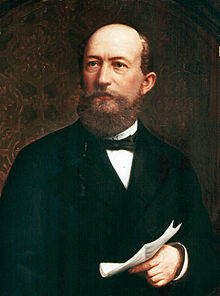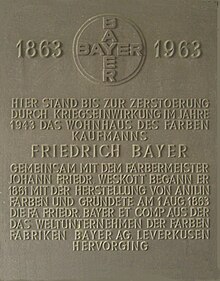Friedrich Bayer (entrepreneur, 1825)
Friedrich Bayer , actually Friedrich Beyer (born June 6, 1825 in Barmen - Heckinghausen (now part of Wuppertal ), † May 6, 1880 in Würzburg ), was a German entrepreneur . In 1863 he founded the paint factory Friedrich Bayer , today's Bayer AG , in Elberfeld (today also a district of Wuppertal), in the then Prussian Rhine Province, together with the chemist Johann Friedrich Weskott .
Live and act
The founding father and namesake of the later Bayer Group was born as the son of the silk weaver Peter Heinrich Friedrich Beyer († 1839) and his wife Maria Catharina , née Utermann . His grandfather had already been a silk ribbon maker in Barmen and came from a family of cloth merchants in Nördlingen . The family, which can be traced back to the 16th century, originally comes from Upper Lusatia / Saxony, where “bajer” means (story) teller.
At the age of 14 he started as an apprentice in the chemicals business Wesenfeld & Co. in Barmen. There Bayer (at that time still “Beyer”) became familiar with the basics and problems of dyeing.
At the age of 20 he started trading in natural colors. Three years later he founded his first trading company and built up a distribution network across Europe. The natural dyes that he initially offered were extracted from colored wood and, due to their high quality, were sold in the European capitals of London , Brussels, Saint Petersburg and even as far as New York .
Around the same time, a fraudulent merchant named Friedrich Beyer from Leipzig made a name for himself. Friedrich Beyer from Barmen feared business damage due to the bad reputation of his namesake and changed his name to Bayer (with "ay").
Bayer married Caroline Juliane Hülsenbusch on September 13, 1848 (March 4, 1829 - January 6, 1899). Bayer had five children with her. His son Friedrich took over the management of the company after his death, his daughter Clara Bayer married Carl Rumpff in 1871 , his daughter Adele Bayer (born August 26, 1856) married Henry Theodore Böttinger .
The discoveries of organic chemistry in the field of dye production and the associated market potential prompted Friedrich Bayer to diversify his sales program. The tar colors aniline blue and fuchsine initially imported by Bayer exceeded the natural colors in terms of their purity and radiance. Together with his future partner Johann Friedrich Weskott , Bayer experimented with their own production and testing of these tar dyes from 1861 onwards. They managed to produce colors that were qualitatively superior to the first generation.
The successful cooperation between Bayer and Weskott led to the establishment of the first small fuchsin manufacturing facility in Heckinghausen . This nucleus of what would later become Bayer AG was founded on August 1, 1863 under the name Friedr. Bayer et comp. registered in the local commercial register. Bayer took over the commercial management of the young company, Weskott the technical management. In 1867 the fuchsin plant was relocated to Elberfeld , while aniline was now being produced in Heckinghausen. The employees August Stiller and Eduard Tust were accepted as partners. In 1872 the Alizarin company was established in Elberfeld. With the support of his son-in-law Carl Rumpff, Bayer expanded the sales organization with many agencies.
Due to further dye developments based on aniline, fuchsine and alizarine , the company founders managed to significantly expand production capacities, despite the now tense overall economic situation.
However, this brought with it enormous environmental problems: the production of fuchsin produced arsenic , which poisoned the neighbors' wells. When their compensation claims became too high, Bayer and Weskott relocated production in 1866 and also the headquarters of their company to Elberfeld (now part of Wuppertal ) in 1878 . At least by the standards of the time, production in Elberfeld is said to have been progressive in terms of environmental and personal protection.
Bayer died in 1880 at the age of 54 on a trip from a dragged pleura. He left behind a family business that, on his death, employed two authorized signatories, 14 chemists, an engineer, 14 commercial employees, 15 foremen and 340 workers. The sons and sons-in-law of the founding fathers (e.g. Henry Theodore Böttinger ) were closely associated with the company as partners.
literature
- Wolfgang Köllmann : Friedrich Bayer . In: Wuppertal Biographies 1st episode . Contributions to the history and local history of the Wuppertal Volume 4, Born-Verlag, Wuppertal 1958, pp. 7-10.
- Franz Hendrichs: Bayer, Friedrich. In: New German Biography (NDB). Volume 1, Duncker & Humblot, Berlin 1953, ISBN 3-428-00182-6 , p. 677 f. ( Digitized version ).
Web links
- Biography of Bayer AG
- Friedrich-Bayer-Realschule Wuppertal ( Memento from June 24, 2014 in the Internet Archive )
Individual evidence
- ^ Often wrongly stated as Wichlinghausen. Correction according to the birth certificate in the Wuppertal city archive (Barmen, birth certificates 1825, No. 53, 419)
- ↑ Thomas Käding: It should actually be called Beyer. In: www.ksta.de. Leverkusener Anzeiger, May 21, 2013, accessed on May 26, 2015 .
| personal data | |
|---|---|
| SURNAME | Bayer, Friedrich |
| ALTERNATIVE NAMES | Beyer, Friedrich (real name) |
| BRIEF DESCRIPTION | German entrepreneur, founder of the paint factory Friedrich Bayer of today's Bayer AG |
| DATE OF BIRTH | June 6, 1825 |
| PLACE OF BIRTH | Barmen - Heckinghausen |
| DATE OF DEATH | May 6, 1880 |
| Place of death | Wurzburg |


